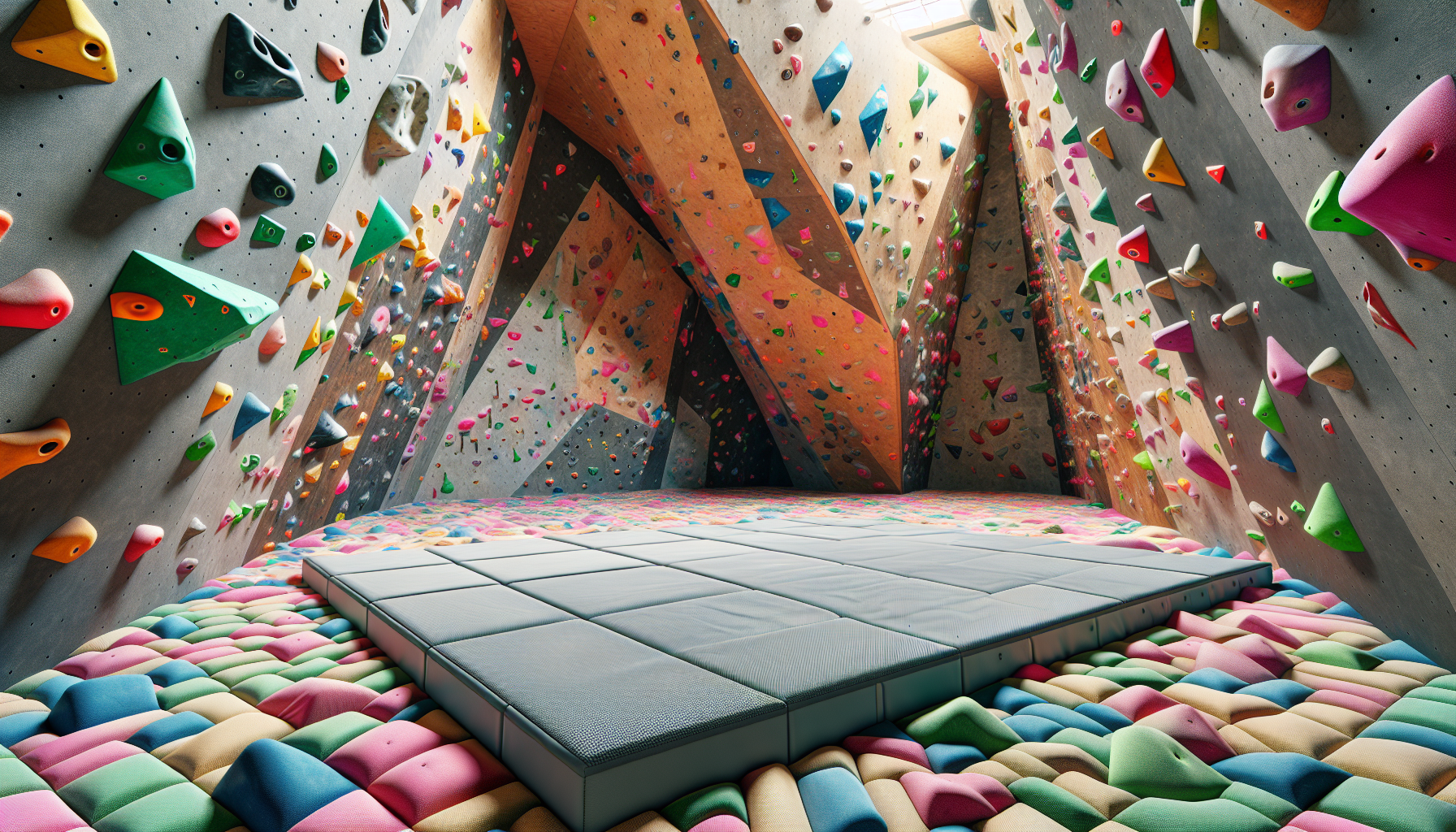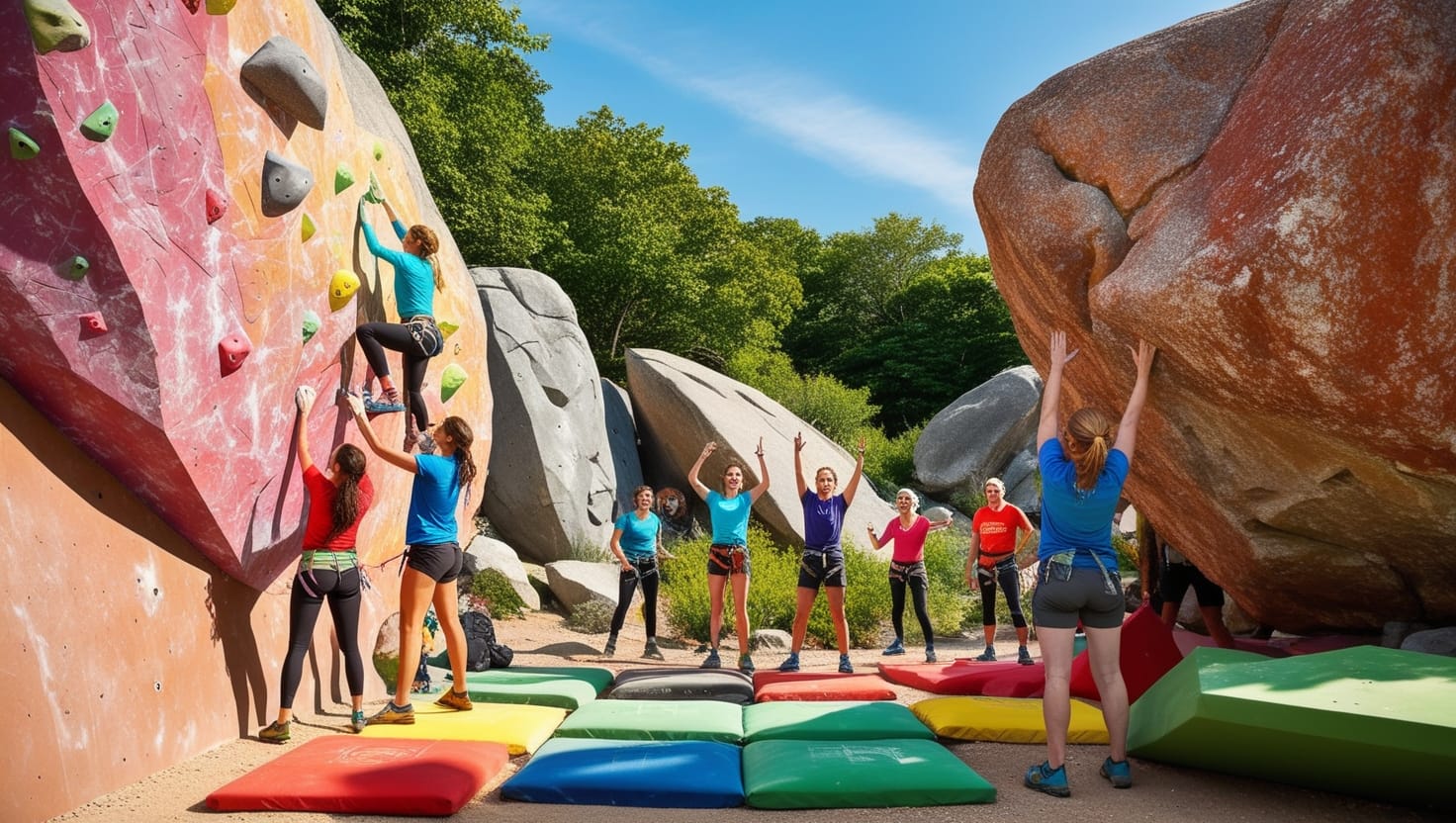Many rock climbers have interesting conversations about how bouldering differs from traditional climbing. At first glance, the two may seem quite alike. However, each activity has its own unique qualities.
For example, bouldering lets people climb on shorter rock structures without safety ropes. This is because they are closer to the ground. In contrast, traditional climbing often involves ropes and gear to protect climbers on taller routes.
Some folks like figuring out which style is the best match for them. Deciding between bouldering and traditional climbing isn’t always easy. Keep reading if you want to find out more about what really sets these exciting climbing options apart. Learning the key distinctions can help anyone choose which type of climbing might be most fun.
Key Takeaway
- Bouldering involves shorter climbs and less gear.
- Traditional climbing requires ropes, harnesses, and more planning.
- Each style offers different physical challenges and social experiences.
Differences in Height and Safety
Credits : Bouldering Bobat
The heights of climbs are very different between bouldering and traditional climbing. For bouldering, walls are usually around 20 feet tall. Since falls wouldn’t happen from very high, safety is more relaxed. Climbers use thick mats called “crash pads” below the rocks to soften falls. Spotters also help catch people or guide them back down if needed. This lets climbers try routes without much prep work.
Traditional climbs can reach hundreds of feet above the ground. Climbing such tall distances requires gear to prevent injury from a fall. Climbers use equipment like ropes tied to their harness and anchors stuck in the rock wall. This keeps climbers securely attached as they climb up. Because the heights are greater, traditional climbing also needs more planning. People must know the route well and check their gear is ready before starting to climb.
Understanding how the heights and safety can be different explains bouldering and traditional climbing. Bouldering allows a simpler time on lower rocks. At the same time, traditional climbing presents bigger challenges on taller cliffsides but keeps climbers attached for safety. Thinking about comfort with heights and safety needs can help choose the style of climbing that fits a person best. Both offer unique ways to enjoy climbing rocks!
Gear Needed for Each Activity
Climbers use different gear depending on if they go bouldering or traditional climbing. Bouldering keeps things simple, with just shoes and mats needed. Special climbing shoes grip the rock well for control. Thick crash pads underneath catch falls safely. With just those two items, someone can start bouldering right away without much preparation.
On longer climbs, gear needs to be more extensive. A harness wraps around the body to hook carabiners and ropes. Ropes extending above catch a person if they slip. Carabiners clip ropes to the harness and wall anchors. Some climbers may also use pieces like camming devices and nuts that lodge in cracks to anchor the rope. All this gear means folks have to organize everything before going up.
Having the proper equipment makes climbing much safer. Bouldering keeps it light, while complex gear protects at height. Understanding the different gear set-ups helps pick which style suits someone best. Whether climbing closer to the ground or higher with protection, choosing the right things to wear and bring allows climbers to enjoy their time on the wall safely. Both bouldering and longer climbs offer fun for anyone able to get ready with what each needs.
Physical Demands of Each Style

Bouldering and climbing each require their own physical skills. Bouldering focuses on power and strength in short bursts. People use strong arm and leg muscles to push off hard and pull themselves up quickly between holds on the wall. They need to hold their body tightly during moves. This style gives intense challenges that workout people’s upper body, core, and finger muscles.
On longer climbs, having endurance is key. Folks may be on the wall for a longer time and need energy throughout. Climbers use leg muscles a lot for pushing up higher. They also need to go at a steady pace so their body doesn’t get too tired facing long routes. Climbing works on technique too, like foot placement and balance skills.
Knowing how their body will engage differently helps someone pick which style fits them. Bouldering is short and powerful, while climbing focuses on enduring over a longer period. Both provide chances to improve strength and skills. Whether going for short intense challenges or long steady progress up high, climbers can have fun getting exercise through bouldering or traditional climbs.
Social Aspects of Bouldering and Climbing
The social aspects are different for bouldering and climbing. Bouldering tends to be more social because groups like gathering at rock gyms or outdoor bouldering areas together. People encourage each other’s attempts and share tips. It’s fun watching friends succeed on tricky climbs. This friendly community feeling is what some enjoy.
On longer climbing routes, fewer people sometimes go alone. More planning goes into picking safe paths. Having the proper gear too can limit spontaneous group trips. While the quiet journey appeals to other climbers, others miss bouldering’s lively socializing.
Each provides unique social scenes. Bouldering promotes a lively environment among peers. Climbing lets people challenge themselves individually or in smaller numbers. Introverts might favor climbing’s solo calm, while extroverts are drawn to bouldering’s team spirit. No matter which someone selects, both deliver their own social dynamics for building friendships around the sport. Where a climber chooses to spend their time rock climbing affects the relationships they form as well.
Highball Bouldering
Some boulder problems reach much higher than usual.
Highball bouldering means climbing on walls over 20 feet tall. This adds excitement but also more risk if a climber falls from higher up. So climbers must be very careful.
Spotters stand below to help guide falls and keep climbers from getting hurt. They talk with the climber so they are ready.
Climbing bigger walls makes feelings of being scared and enjoying the challenge. Climbers have to not be afraid of maybe taking a tumble. Many say it helps skills like body control and knowing where to put hands and feet. It also teaches being tough in your mind too.
But highballing is not for anyone. Climbers must think carefully if a boulder matches their ability to stay safe having fun up high. With good safety plans and being smart about tall problems, highballing can provide thrill without as much danger if climbers are sensible what they try. Working together and making good choices helps climbers enjoy testing themselves up on the rock (1).
Injury Risks in Bouldering vs Climbing
Bouldering and climbing each pose some injury risks, but the types tend to differ. With bouldering, any falls typically happen from lower heights. This often results in minor issues like bruises or twisted ankles from landing on the crash pads. While still uncomfortable, such injuries usually heal quickly. Using thick landing mats and having spotters watch helps reduce the chances of harm.
In traditional climbing, accidents are less frequent since safety gear is used. However, potential injuries could be more serious given the greater heights. A slip while high up might cause very bad damage. Equipment failures on ropes also present scary situations. That’s why climbers must carefully check all gear before starting tall climbs.
Understanding how mishaps tend to occur in each activity helps people be aware. Bouldering usually means dealing with smaller bumps and sprains. At the same time, climbing brings less frequent but possibly very serious falls. For both styles, safety always comes first. This involves managing risks properly and climbing within one’s abilities. With preparation and choosing suitable problems, climbers can enjoy their time on the rock while avoiding major trouble. Whether lower down or higher up, taking care helps climbers have fun while staying safe.
Training Benefits of Bouldering
Bouldering makes a good choice for training climbers, especially people who climb on longer routes too. Doing bouldering moves builds strong arm, hand, and core muscles through short bursts. Climbers practice technique like reading holds and finding efficient ways up by solving separate problems.
Many use bouldering to get better at other types of climbing. Focusing on strength and skills transfers over to longer climbs. Bouldering’s quick pace also improves mental game – learning to think fast when stuck. These benefits aid tackling challenging routes.
In addition, completing tough boulder problems can boost confidence. Feeling ready for taller climbs happens after success on hard issues close to the ground. Bouldering provides fun but also valuable practice to enhance a climber’s whole performance, whether just for enjoyment or competition. It’s not just play – bouldering seriously develops climbing abilities.
Climbing Gyms and Their Offerings
Climbing gyms are popular spots for bouldering and routes. They offer a controlled, safe place to practice. Most have separate sections, with shorter walls set up for bouldering problems of varying difficulties. This lets people choose the level that matches their skills.
For longer climbs, gyms commonly have taller structures with attachment points like anchors. This environment allows learning skills like belaying a partner from below safely. Gyms often provide lessons for all experience levels too. Beginners gain basics while advanced folks refine abilities.
The community aspect is great too. Lots of climbers meet friends at gyms. Planned socials, competitions, and group sessions help connect people who share the hobby. Whether hitting boulder problems or roped walls, gyms provide a welcoming atmosphere for all to improve skills and spend time with others who enjoy the sport. They make a fun spot to learn rock climbing in a supported environment (2).
Mental Aspects of Climbing
Rock climbing challenges climbers mentally as well as physically.
Bouldering requires fast thinking. Figuring out tricky sequences on the fly helps climbers adapt under pressure. Staying calm even when moves get tough builds strong focus. Handling any fears is an important part of getting better.
Longer routes mean planning ahead too. Picking lines based on energy levels ensures reaching the top. Always considering safety like the gear uses keeps people protected.
Both improve decision making. Learning to stay centered under stress aids performance. Developing these mental skills, just like physical ones, can boost climbing ability overall.
Whether bouldering or roped climbs, mental strength matters as much. Understanding this allows enjoying the sport more while sending harder routes. Climbers develop important lifelong skills no matter their chosen style when treating mind fitness seriously too.
Popular Climbing Competitions
Climbing contests offer fun challenges for boulderers and roped climbers alike.
Bouldering competitions have people solve a set number of problems before time runs out. Climbers cheer each other on through the round. Indoor and outdoor events let different skill levels compete. The teamwork vibe builds community.
Roped climbs sometimes have lead contests, where quickly and smoothly reaching the top scores highly. Speed rounds focus on racing to the bell fast. Careful planning and techniques give the edge.
Contests help folks test limits and learn from others. Seeing new moves widens talents. Participating raises confidence and skills over time for many. Win or lose, climbers celebrating their shared passion marks the true competitive spirit. Whether tackling boulders or routes under pressure, competitions motivate climbers to keep enhancing what they love about the sport (3).
FAQ
What are the main differences between bouldering and climbing?
There are a few key ways that bouldering and climbing are different. Bouldering is done on shorter walls, usually under 5 meters high. It focuses on powerful moves to reach the top. Climbing routes go much higher. They require endurance and concentration over a longer distance.
Bouldering needs a mat to land on if you fall. Climbing needs ropes, harnesses, and devices to attach the rope for safety. They also use different grading systems. Bouldering uses the font scale. Climbing uses the Yosemite decimal system.
How do indoor and outdoor climbing compare?
Indoor and outdoor climbing have some differences in where they happen and what gear is needed. Indoor climbing is in a gym on artificial walls. Route setters make the problems and routes.
For outdoor climbing, you climb on natural rock formations. More safety gear may be needed like anchors, ropes, and harnesses depending on the type of climbing.
Indoor facilities provide much of the safety equipment. When outdoor climbing, you often need to bring your own gear like ropes, harnesses and other anchoring equipment depending on the climb.
What’s the difference between types of climbing like sport climbing, trad climbing, and free soloing?
Sport climbing uses pre-placed anchors, while trad climbing requires placing your own protection. Free soloing, made famous by climbers like Adam Ondra, means climbing without ropes or harnesses – it’s extremely dangerous. These form of climbing each need different climbing skills and mental preparation. Most climbers start with top rope climbing before advancing to other styles.
How do bouldering grades compare to rock climbing grades?
The boulder grade rating system differs from climbing grades. Bouldering problems use the font scale (starting at 3 and going up to 8C+), while rock climbing routes use systems like the Yosemite decimal system (5.0 to 5.15d). These grading systems help climbers understand the difficulty of boulder problems and climbing routes.
What makes form of rock climbing different from bouldering in terms of physical demands?
Rock climbing requires more power endurance since you’re climbing longer routes, often 20-30 meters high. Bouldering and lead climbing focus on different aspects – bouldering emphasizes explosive power for short, intense problems, while climbing demands sustained endurance and mental focus. Your climbing journey might include both, as they complement each other well.
How can beginners get started with climbing and mountaineering?
Visit a rock climbing gym where staff writers can guide you through basics like using chalk bags and trying both bouldering walls and top roping. Many climbing areas in the United States and South Africa offer great outdoor adventures for all skill levels. Most climbers start indoors before heading to outdoor climbing locations listed on Mountain Project.
What climbing pants and chalk bags should I bring for my first climbing experience?
Start with comfortable climbing pants that allow movement. Bring a chalk bag (many like Black Diamond) to keep your hands dry. For bouldering, you don’t need ropes or harnesses, but you’ll want proper climbing equipment including climbing chalk and crash pads. Indoor bouldering requires minimal gear compared to other types of climbing.
What makes alpine climbing unique compared to other climbing styles?
Alpine climbing combines climbing skills with mountaineering in high-altitude environments. Unlike sport climber focused activities or bouldering problems, alpine climbing often involves longer climbing routes on rock formations in remote areas. This form of climbing requires extensive outdoor climbing experience and knowledge of safety equipment for varying conditions.
Conclusion
Bouldering and climbing are both ways people go up rock. But they have some big differences. Bouldering is closer to the ground and needs strong muscles. Climbing often goes higher so ropes are used to stay safe on tall rock. Each lets climbers try climbing in different ways. Some like bouldering’s short tries. Others prefer climbing’s longer paths up rock. Both can excite people through challenge. Both are fun ways to enjoy moving on rock.
References
- https://www.nationalgeographic.com/adventure/article/boulderer-daniel-woods-trades-comfort-for-fear-in-new-reel-rock-film
- https://manofmany.com/entertainment/sport/best-rock-climbing-bouldering-melbourne
- https://www.redbull.com/us-en/bouldering-routes-only-the-best-can-manage






